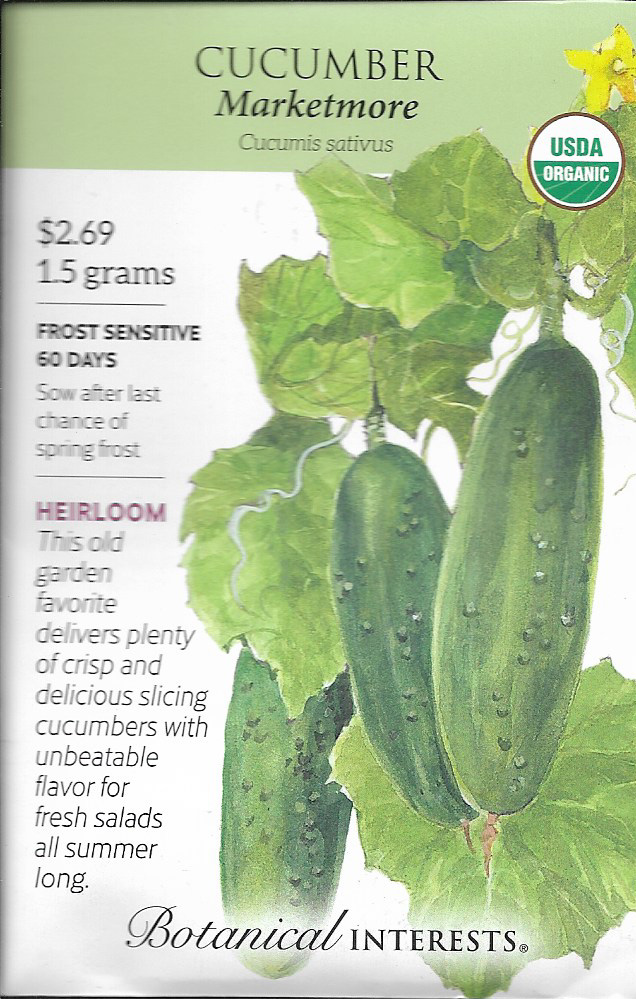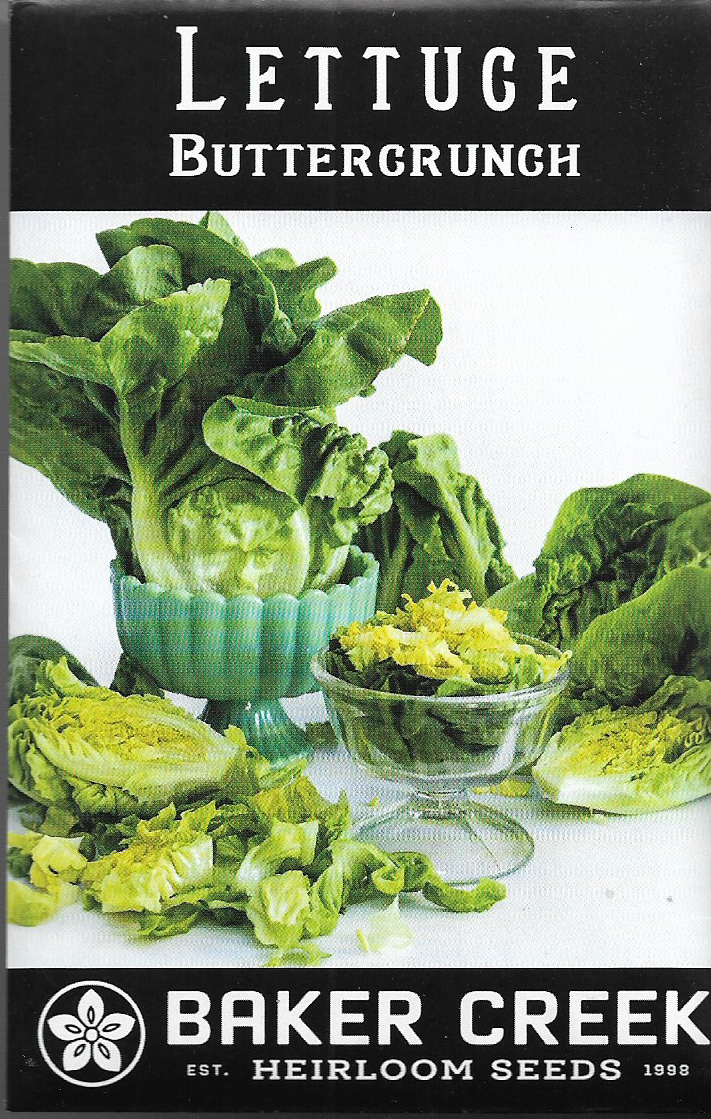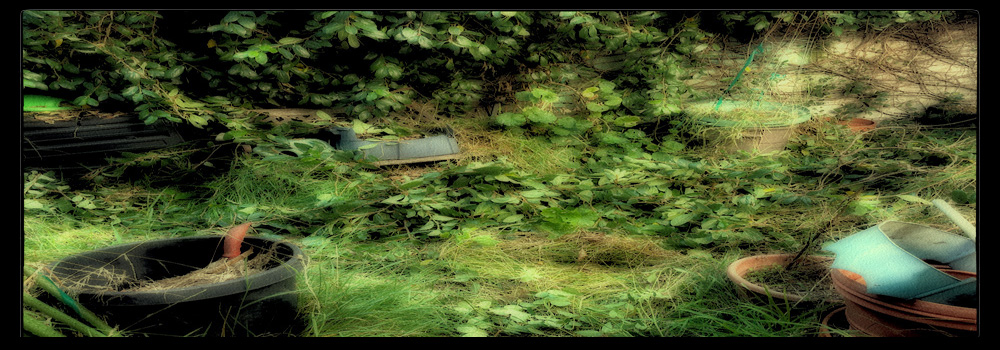
Adventures in an Urban Kitchen Garden
VEGETABLES 2025
|
|||||||||||
|---|---|---|---|---|---|---|---|---|---|---|---|
| 1 Artichoke (Started seedlings the last week of December, 2023. It is now February 10, 2025 and the plants (2 of them) look good. 150-180 days Sprouts in 14 days Ideal germ.temp: 70-80 F Seed depth: 1/8-1/4 inch Plant spacing: big pot Averages 3-5 artichokes per plant Artichoke should be planted 3-4 weeks before the frost-free date for your area. Artichoke requires cool spring temperatures to initiate the flower stalk. If planted too late, plants do not get the required chilling, therefore, plants will not flower. Space plants 18 inches apart in the row, with rows 2-3 feet apart. Planting through plastic mulches accelerates early growth and leads to higher yields. Water frequently after transplanting to ensure good root and shoot growth. Maintain healthy vigorous growth during the spring and summer to ensure that artichoke produces for a long time. Water frequently during the year by supplying 1 to 2 inches per week in several applications. Use drip irrigation if possible. Mulch heavily around the plants with an organic mulch like compost, grass clippings, or straw to conserve soil moisture and reduce weed growth. Mulches help keep the soil cool. Artichoke has a shallow root system, does not tolerate hot, dry conditions and likes moist soils if high productivity is expected. Artichoke requires high amounts of nitrogen fertilizer for best growth and development. Apply 2 teaspoons per plant of a nitrogen-based fertilizer (21-0-0) every 4 weeks beginning 4 weeks after transplanting to encourage sustained and rapid plant growth. Place the fertilizer to the side of the plant and irrigate it into the soil.
To get a crop of artichokes in one year, start seeds indoors in pots 2 to 3 months before the last frost date in spring. Move the pots outdoors when four leaves have developed. Sow seeds 1/4 to 1/2 inch deep. When temperatures are occasionally freezing, protect plants if temperatures fall below 29 degrees. Two to four weeks of exposure to cool temps “vernalizes” the young seedlings, preparing them to bloom later in the season after plants have grown large. Seeds germinate in 10-21 days. Ideal germination temperature is 60-80 F. Artichokes prefer 6-12 hours of full sun. Provide rich, deep, well-drained soil and ample moisture. Seedlings require a chill period (nights below 45 F but above freezing) to produce artichokes. Mature plants produce many buds over a long season. Simply cut off each bud, with an inch of stem, when it has reached its full size but before the “scales” begin to separate, which signals that the bud is about to bloom. After harvest you can cut the plant down to the ground and mulch it. Mulching can allow artichokes to act as a perennial in zones 5 or 6, where there are usually not sustained periods of deep freezes.
|
|||
|---|---|---|---|
|
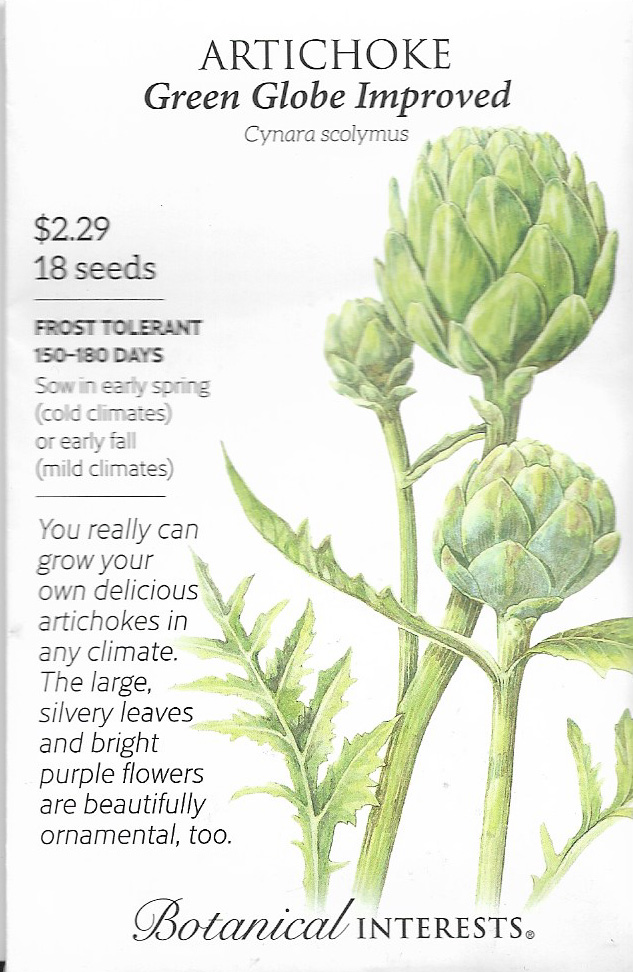 |
a) Green Globe Improved |
|
| 10 Cucumber (Start seedlings on February 16) 65 days Sprouts in 5-14 days Ideal temp: 70-90 F Seed depth: 1/2" Plant spacing 12" Marketmore, 24" Boston Pickle Min. full sun: 8-12 hours Direct seed cucumbers ½ inch deep when soil has warmed to at least 65 degrees. For an early crop, start indoors 1 week before last frost date; transplant out when plants are 3 weeks old. Seeds germinate in 7-14 days. Ideal temperature is between 70-90 F. Cucumbers need moist, rich soil. Shade is beneficial in the hottest weather of summer. Trellis cukes to save space and make weeding, mulching and harvesting easier. Harvest frequently to maintain production. Cucumbers will peak quickly and die, so it is best to succession plant cucumbers every two weeks until late summer. Radishes are a great companion plant for cucumbers. A layer of mulch will retain moisture and suppress weeds. |
|||
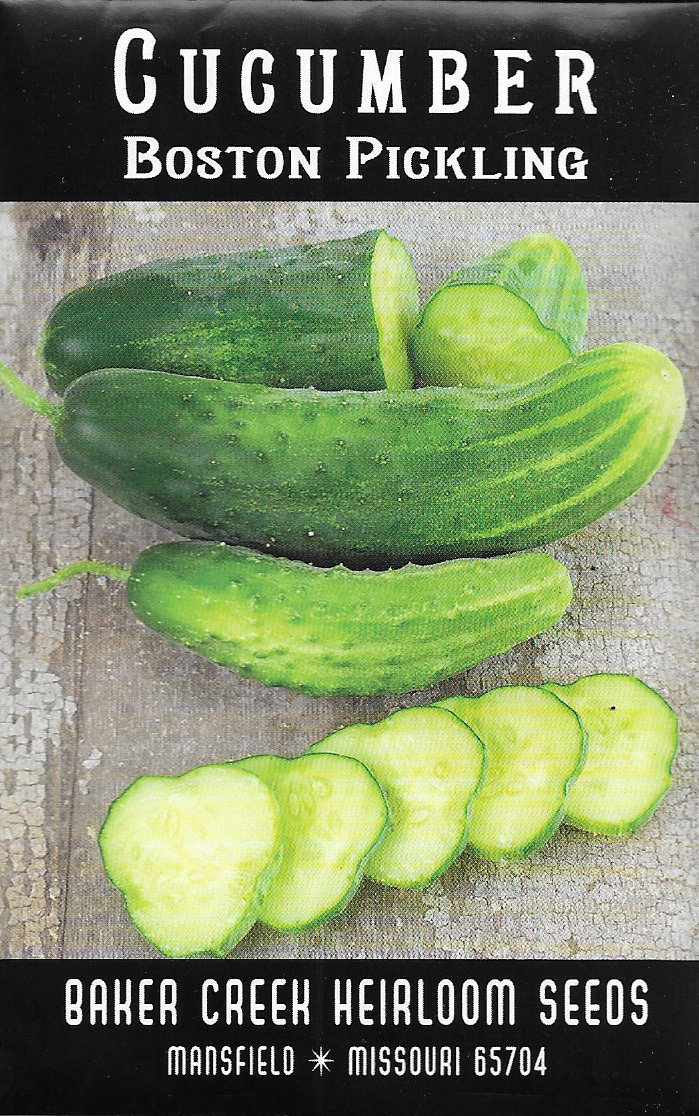 |
a) Boston Pickling An old heirloom dating back to 1880. Vigorous vines give large yields of smooth green fruit. It is excellent for pickles; very crisp and good quality. A very popular variety at the turn of the 20th century. |
||
|
Family: Cucurbitaceae Type: Monoecious, slicing cucumber Native: Southern Asia Hardiness: Frost-sensitive annual Plant Dimensions: 4'–6' vines Variety Info: 6"–8" long, 1 ½"–2" thick fruits with dark green, smooth, medium weight skin. 'Marketmore' was developed at Cornell University and introduced in 1968. Plants are resistant to cucumber mosaic virus. Days to Emerge: 5–10 days Seed Depth: ½" Plant Spacing: 12"
|
||
|
|||
| 14 Lettuce(Start seedlings on February 16)
Baker Creek Seeds: Sprouts in 7-10 days Ideal temp: 50-75 F Seed depth: 1/4 inch Plant spacing 8" Min. full sun: 4-8 hours Botanical Interests Seeds: Sprouts in 5-10 days Ideal temp: 60-70 F Seed depth: 1/8th inch Plant spacing 8" Maturation days in specific varieties You can seed densely for loose leaf varieties and thin to 4 inches per plant; for heading types, space plants about 8-12 inches apart. Sow seeds ¼ inch deep. Ideal germination temp is 60-80 F. Seeds germinate in 7-10 days. Apply ¼ cup of a nitrogen based fertilizer (21-0-0) per 10 foot of row 4 weeks after transplanting or at thinning to encourage rapid plant growth. Place the fertilizer to the side of the plants and irrigate it into the soil. Summer’s heat and drought are the most common enemies of a successful lettuce crop. Try to grow in a shady location or under shade cloth to keep greens cool. Slugs can be an issue with lettuce. |
|||
|
a) Buttercrunch - WINNER! Buttercrunch set the standard for classic butterhead type lettuce for many years. Soft, buttery-textured leaves enclose a crisp, juicy, loose inner head of blanched, sweet-tasting leaves. Very heat tolerant and slow to bolt, Buttercrunch stays mild long after others have turned bitter. Developed by George Raleigh, Cornell University, and an All America Selection for 1963.
|
||
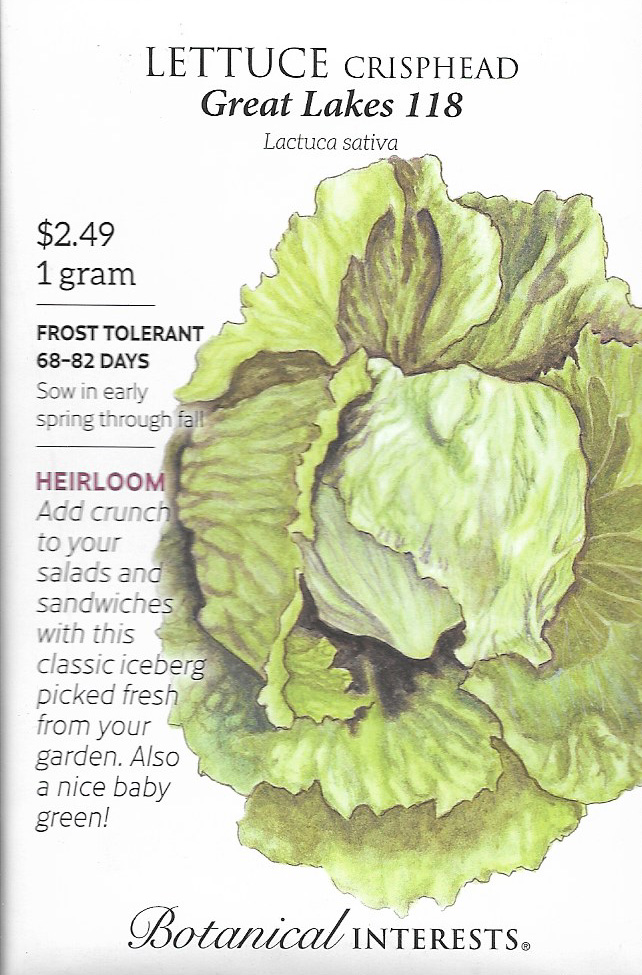 |
b) Crisphead Great Lakes 118 - 68-82 days - GREW WELL BUT NOT THAT DELICIOUS No other lettuce type provides the incredible, cool crunch of crisphead (also called iceberg). 'Great Lakes 118' is a 1960s improvement over the original 'Great Lakes'; heat tolerant, and bolt resistant. Toss it in with your salad mixes or top your sandwiches to liven them up. Days to Maturity: 68–82 days Family: Asteraceae Hardiness: Frost-tolerant annual Plant Dimensions: 6" diameter Variety Info: Very compact, round heads with green outer leaves and a blanched center. Heat tolerant, and bolt, scald, and tip burn resistant. Bred to be larger and firmer than the crisphead lettuces developed earlier in Europe, known as Batavia or summercrisp types. |
||
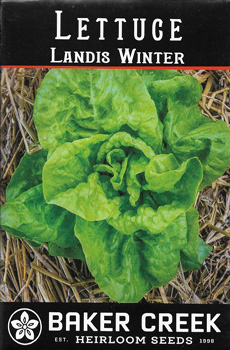 |
c) Landis Winter- WINNER! Roughwood Seed Collection acquired this dark green classic Pennsylvania Dutch winter lettuce in 1994 from the well-known lettuce collector Mary Schultz of Monroe, Washington. A Pennsylvania Dutch selection of the now-extinct late 1700s variety known as White Tennisball, this is one of the hardiest, most frost-resistant lettuces we have ever grown. It even survived the Polar Vortex during the severe winter of 2013-2014. Each head reaches 11 to 12 inches in diameter with a loose butterhead appearance. Plant 14 inches apart in early September for salad greens through December and January. |
||
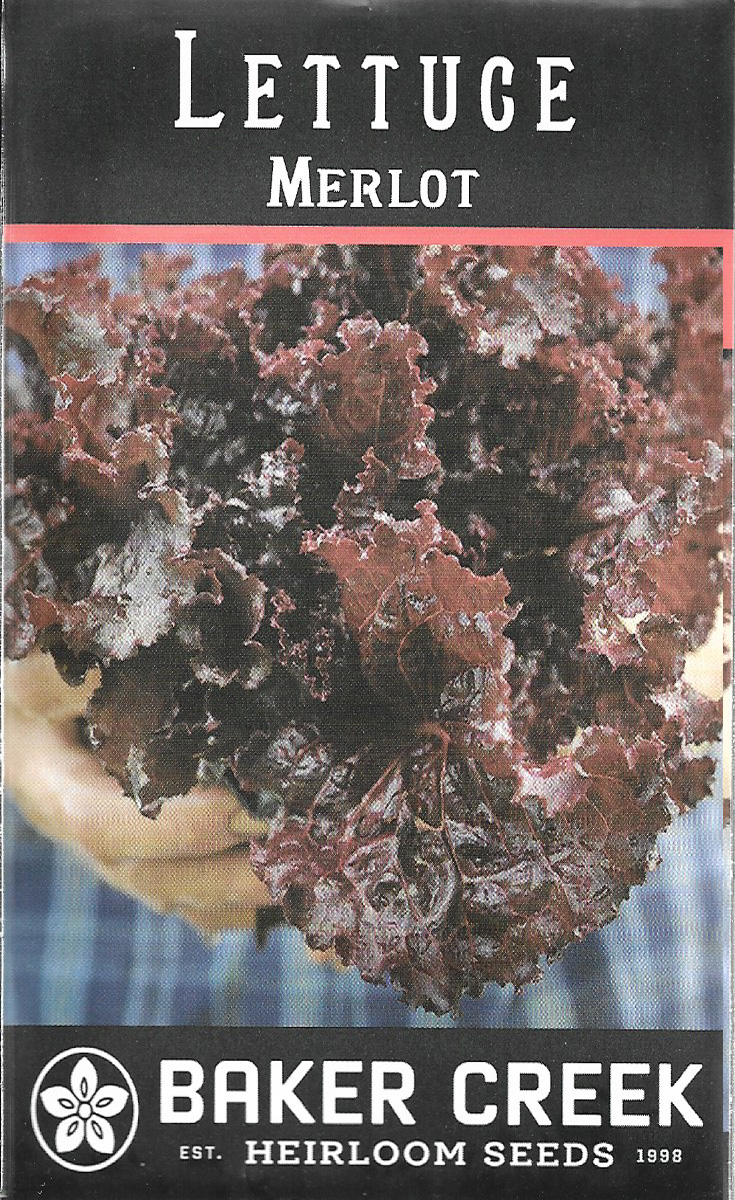 |
d) Merlot - Start seedlings on January 14- WINNER! Reputed to be absolutely the darkest red lettuce in existence, which should make it tops for anthocyanin (antioxidant) content as well! Leaf lettuce with wavy to frilly leaf margins and very crisp, waxy leaves! Excellent bolt resistance, and good cold tolerance for a late fall to winter crop. Recommended as a cutting type for baby greens production or cut-and-come-again harvesting. We feel, along with our friend William Woys Weaver, that this variety is destined to become a classic, and it certainly deserves it! A rich source of potassium and vitamin A.
|
||
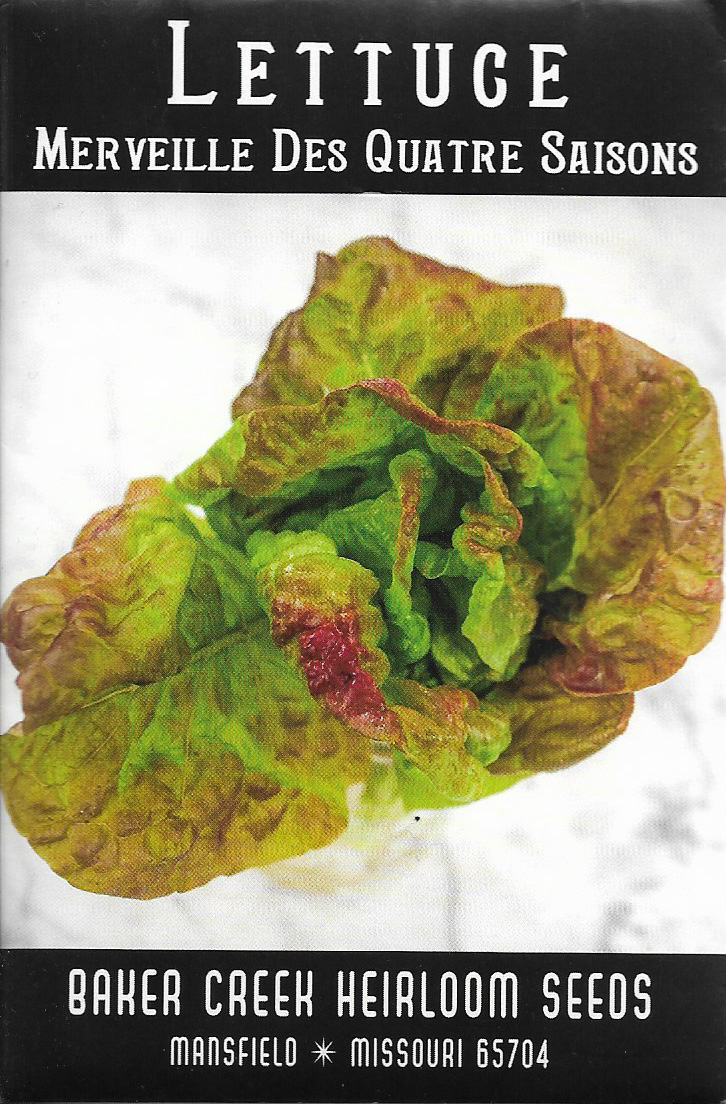 |
e) Merveille Des Quatres Saisons- WINNER!
|
||
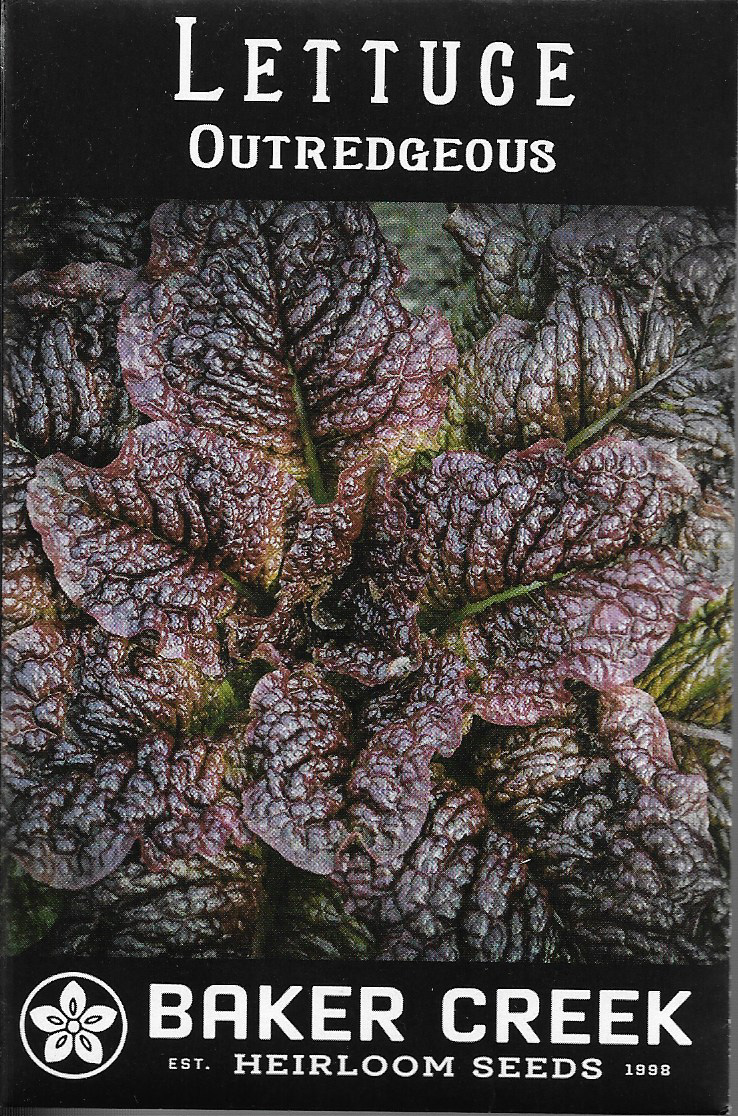 |
f) Outredgeous- WINNER!
|
||
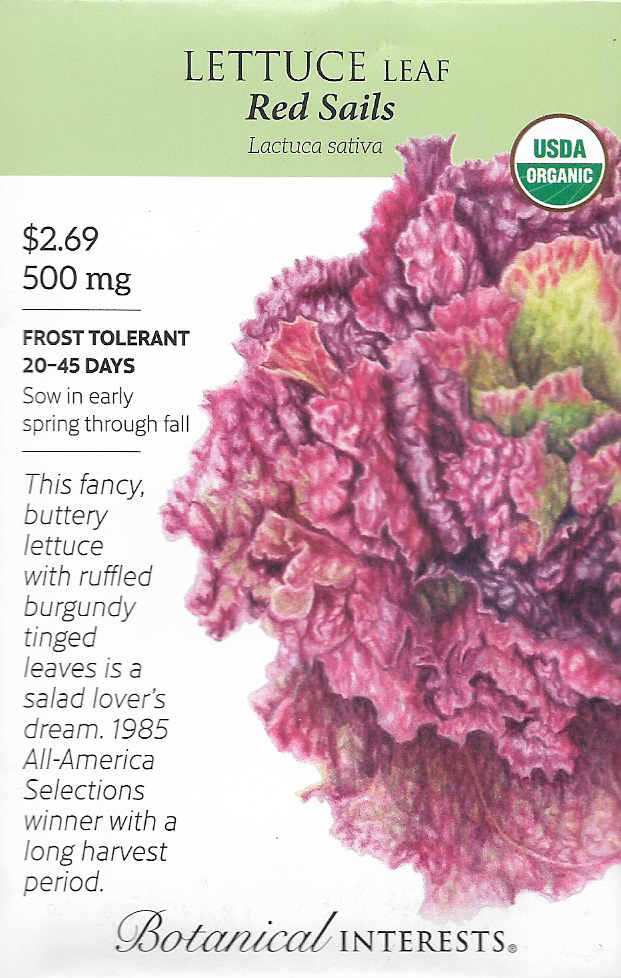 |
g) Red Sails - 20-45 days- WINNER! A favorite to use as baby greens, 'Red Sails' is ready to harvest after just 2 or 3 weeks and grows to a full head in just over 6 weeks. Very heat tolerant, the soft buttery leaves will grow well into warm weather without getting bitter. Contains more vitamins A and C than grocery-store lettuce! Attractive container variety, too. An All-America selections winner. Days to Maturity: 20 –45 days Family: Asteraceae Hardiness: Frost-tolerant annual Plant Dimensions: 10"–12" tall and wide Variety Info: Light green, crinkled leaves turn to deep red-bronze on the frilly edges. When to Start Inside: 4 to 6 weeks before your average last frost date, and in summer when soil temperatures are too warm (above 80°F) to germinate lettuce seed. Days to Emerge: 5–10 days Seed Depth: Surface to ⅛" Plant Spacing: 10"
|
||
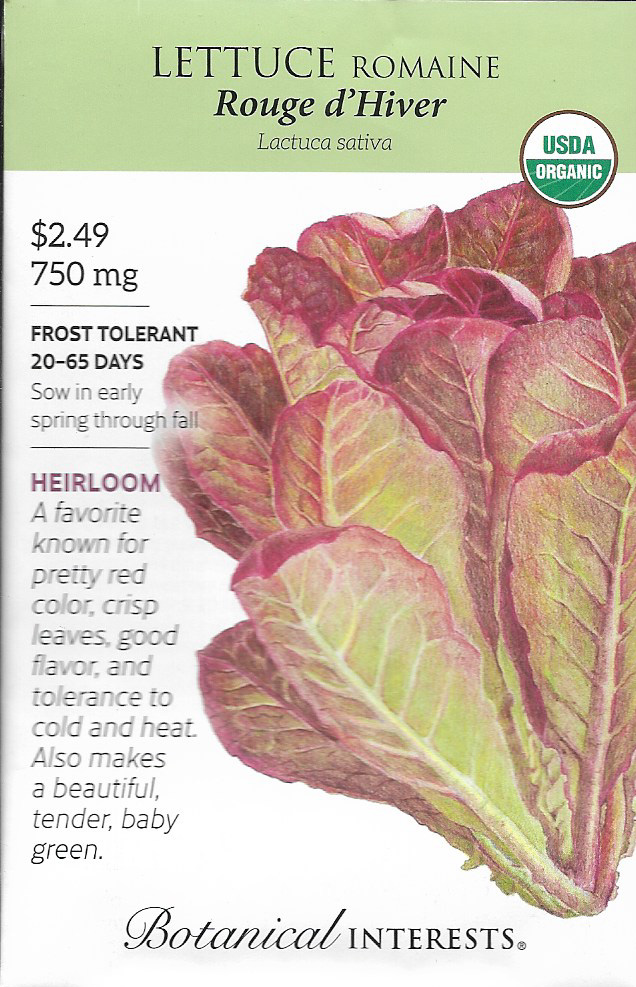 |
h) Rouge d' Hiver- WINNER! This wonderful French heirloom from the 1800s has been pleasing gardeners with its rich, buttery flavor for more than a century. Compact, 12" tall head with a tender green heart surrounded by bronze-red leaves. The name fittingly translates to "Red Winter", as it is cold tolerant and resists tip burn. Ideal for fall planting. Days to Maturity: 20–65 days Family: Asteraceae Hardiness: Frost-tolerant annual Plant Dimensions: 6"–10" tall, 8"–10"wide Variety Info: Upright heads have bronze-red leaves and a green heart; develops best color in cool weather. 'Rouge d´Hiver' is a compact lettuce; a French heirloom from the 1800s. |
||
| 16 Onion (Start seedlings on February 16) Baker Creek Seeds: Sprouts in 7-14 days Ideal temp: 45-80 F Seed depth: 1/4 inch Plant spacing 5" Min. full sun: 6-12 hours Botanical Interests Seeds: See specific varieties Johnny's Seeds: See specific varieties Plant seeds ¼-½ inch deep in rows 8-16 inches apart. Seeds germ in 7-14 days. Seeds, sets or transplants should be planted 3-4 inches apart in the row. If planted at closer spacing, thin to the suggested spacing and use the pulled plants as green onions. Side-dress onions with nitrogen in May and June to ensure good growth and high yields. Onions require regular watering, so keep soils moist. Water stress will reduce yields and bulb size. Organic mulches help conserve water, supply extra nutrients and reduce weed growth. Control weeds, insects and diseases throughout the year. Harvest onions when the tops fall over and papery skins have formed. Bulbs store best in cold, dry conditions to maintain best quality. Onions need additional nitrogen fertilizer to produce optimum yields. Side-dress onions with ½ pounds of nitrogen fertilizer (21-0-0) per 100 square feet in mid-May and again in late June. Do not fertilize after mid-July as extra nitrogen stimulates late season leaf growth and reduces storage potential of dry onions. Onions prefer cool temps (60 F is ideal), and they will start out slowly. Set out acclimated, stocky seedlings 4-6 weeks before the last frost of spring. Plant onions in rich, moist, well-drained soil. Space 6 inches apart in rows 12 inches apart. Consider planting onions with cabbage relatives; i.e., cauliflower, broccoli, Brussels sprouts and radishes. The sulfur from the onions may help deter pests.
|
|||
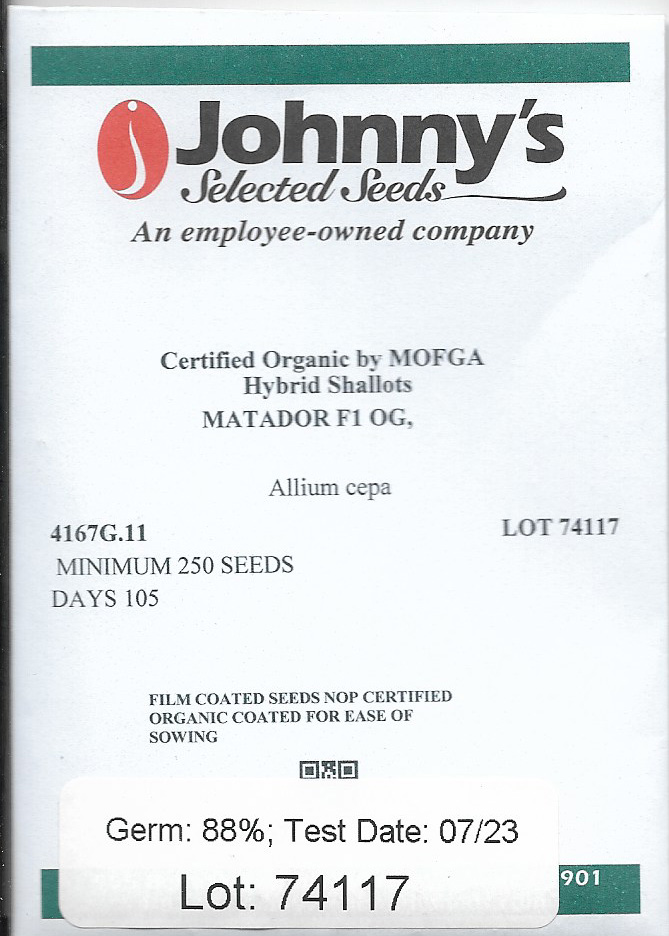 |
a) Matador Shallots - Started seedlings on January 14. They failed. Restarted 5 seeds on February 11th. |
||
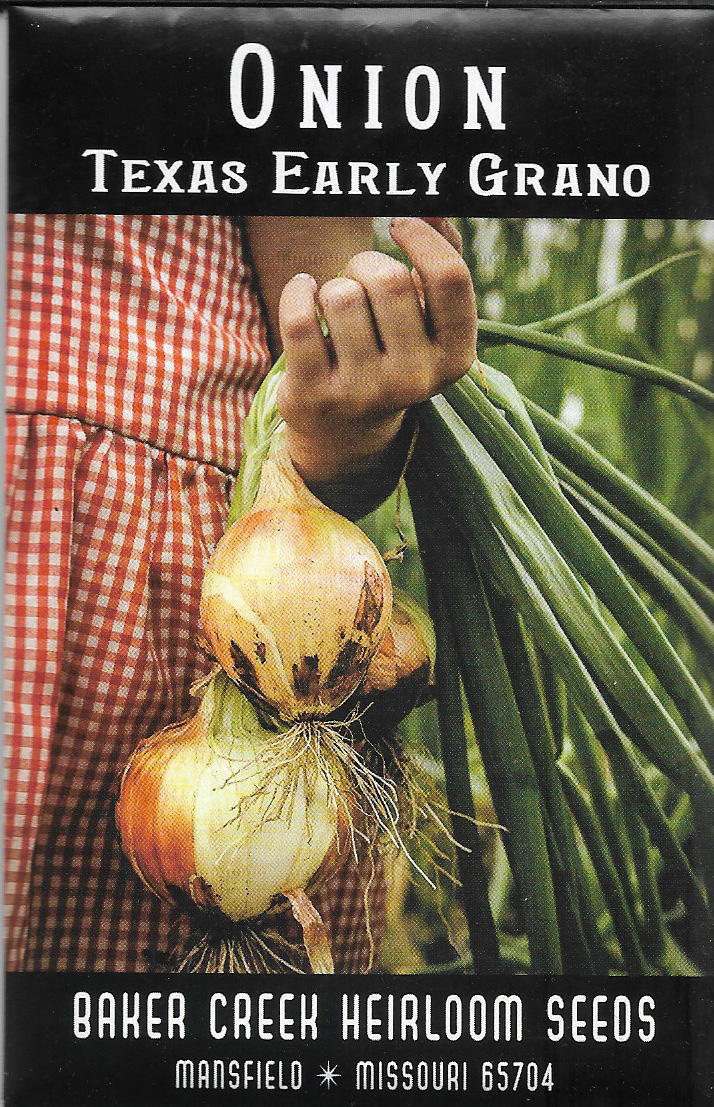 |
b) Texas Early Grano This sweet, white short day onion has been proudly grown in the Lone Star State since 1944. The Grano onion was originally introduced to the U.S. in 1925 from Valencia, Spain. In the 1930s the Texas Agricultural Experiment Station began an onion breeding program; the Grano was trialled and selected for early maturation and extra-sweet flavor, and thus the Texas Early Grano was born. These extra-sweet and early Vidalia-type onions have a thin skin and supremely mild flavor, so sweet they can be eaten like an apple! SLOW TO GROW |
||
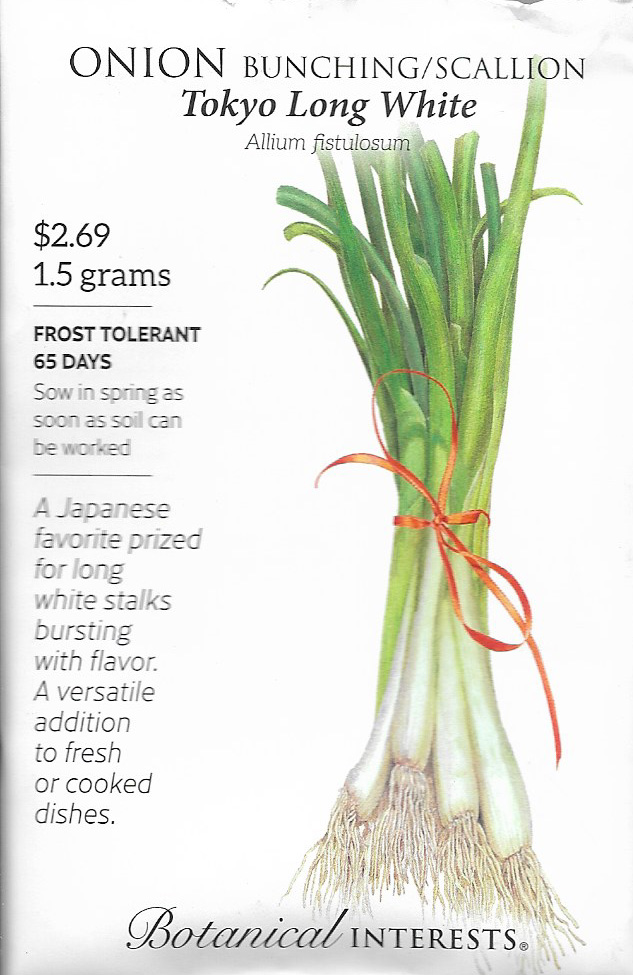 |
SLOW TO GROW | ||
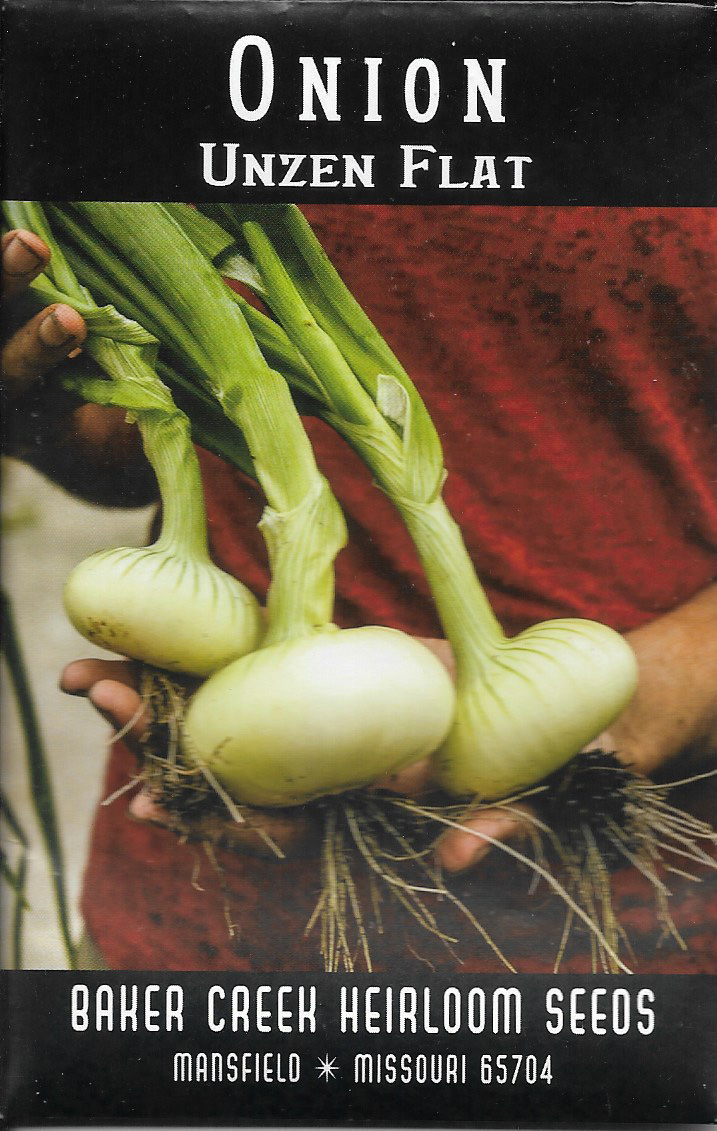 |
d) Unzen Flat SLOW TO GROW |
||
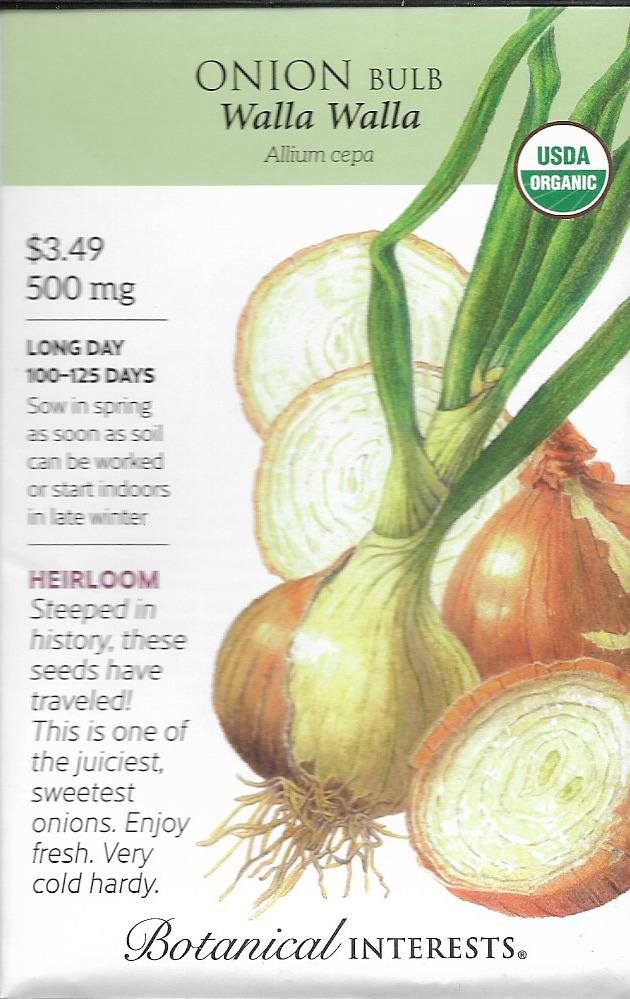 |
e) Walla Walla |
||
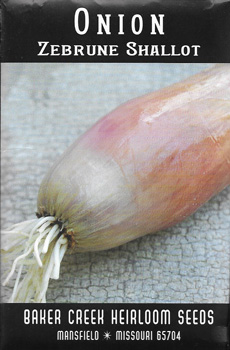 |
f) Zebrune Shallot Cuisse de Poulet du Poitou Is a gorgeous heirloom French eschalion or “banana” type shallot yields plump, long, torpedo-shaped bulbs. Bulbs are brown tinged with pink. The flesh is very mild and sweet, and large yields may be had starting the first year from an early planting. Excellent keeping quality makes these gourmet shallots useful over a very long season! 6-12 hours of Sun
SLOW TO GROW |
||
| 18 Peppers (Started seedlings on February 10.) 65-100 days Sprouts in 7-14 days Ideal temp: 70-95 F Seed depth: 1/4" Plant spacing: big pots Min. full sun: 8-12 hours Start seeds indoors eight to 10 weeks before the last frost date. Provide a heat mat to encourage germination. Grow them under good light or in full sun. In good temps (80- 85 F) seeds sprout promptly. Sow seeds ¼ inch deep. Seeds germinate in 7-10 days. Allow 8-10 weeks to grow transplants. Transplants should have 6-9 mature leaves and a welldeveloped root system before planting. Germinate seeds at 80ºF until the seed root emerges, then transfer seeds to sterile seeding mix and grow out at 65-75ºF. Adequate light is essential to produce quality transplants. Cool fluorescent tubes 2-3 inches above the plants, lit for 14–16 hours per day will ensure plants grow big and healthy. Water regularly and feed weekly with half strength soluble complete fertilizer before planting into the garden. Transplants mature about 4 weeks before seeded peppers. Side dress with additional nitrogen fertilizer to help grow a large plant. Irrigation should be deep and infrequent. Plastic and organic mulches help conserve water and reduce weeding. Do not apply organic mulches until soils have warmed to 75ºF. Control insect and diseases throughout the year. Harvest peppers when the fruits are fully colored but still firm. At the end of the season, gather all mature green and slightly colored fruits and store at 55ºF Avoid over-fertilizing peppers which encourages excessive foliage growth and delays fruit set and maturity. Side dress each plant with 1/4 tablespoon of (21-0-0) fertilizer, 4 and 8 weeks after transplanting. Place the fertilizer 6 inches to the side of the plant and irrigate it into the soil.
|
|||
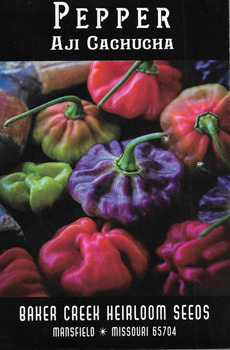 |
a) Aji Cachucha Sweet This is the beloved pepper also known as Aji Dulce that is so popular in the Caribbean and part of Latin America. Pods are reminiscent of Scotch Bonnet, but only in shape -- the heat level is super mild, just about 500-1,000 Scoville units, which is much more mild than a habanero. This sweet-fleshed pepper is essential for so many dishes, from sofrito to bean dishes, soups and even just as a raw snack. It is exceptionally versatile and appreciated for its incredible flavor.
|
||
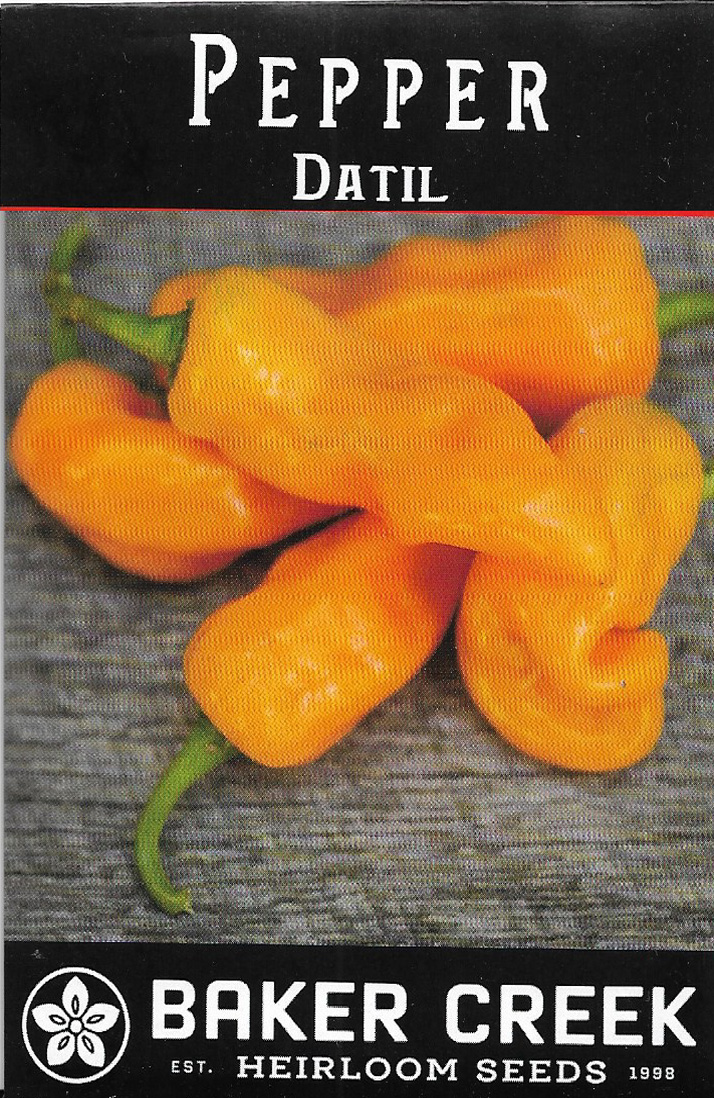 |
b) Datil BURSTING with fruity, hot goodness! Perfect for spicy salsas, sauces, and fabulous jellies! The renowned pepper originating from St. Augustine, Florida. Local legend says the peppers were brought there from Spain, where they do enjoy a following in Minorca. However, they may also have originated in Chile. Blazing hot, blunt little 3.5-inch fruit ripens to a brilliant orange yellow. The heat is vicious, being comparable to habanero types, but the flavor is more complex, sweeter, and more fruity.
|
||
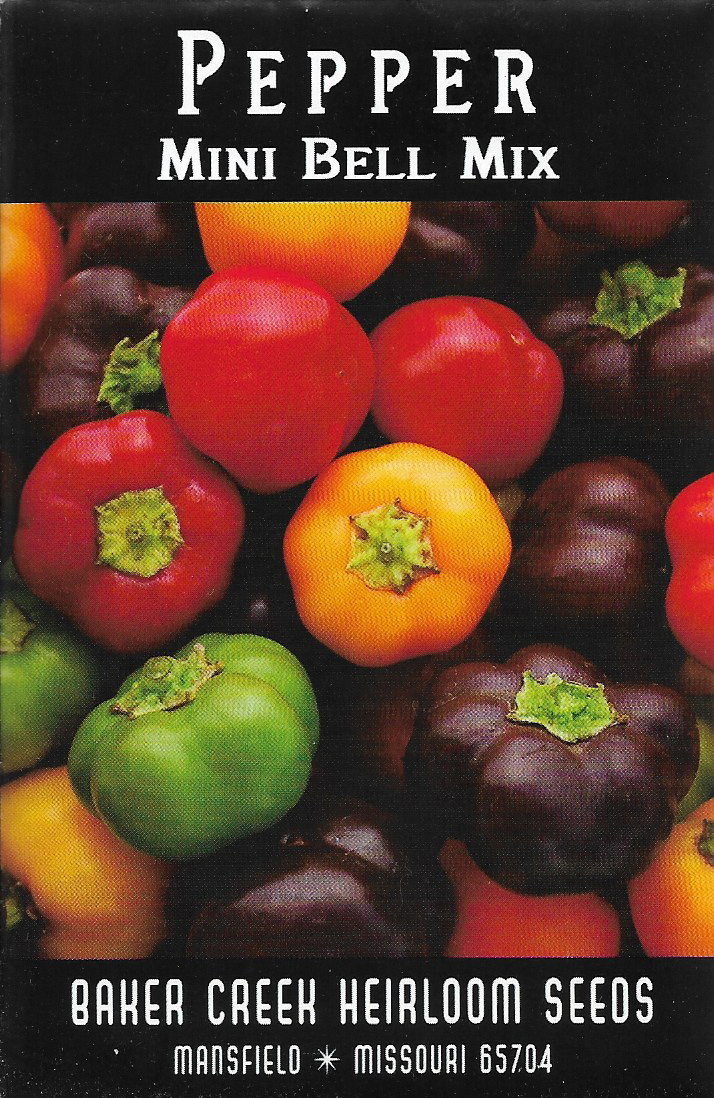 |
c) Mini Bell Mix (sweet) This colorful mix of dainty bell peppers is an old Ohio family heirloom. This trio of mini red, yellow and chocolate bell peppers was introduced to the Seed Savers Exchange by member Lucina Cress. Lucina received the seeds from an elderly neighbor woman and began to grow them out. The 2-inch mini bell peppers became locally famous, as Lucina would sell hundreds of jars of cabbage-stuffed pickled peppers at her local church bazaar each year. We love these little peppers for snacking, stuffing or pickling. Plants produce an abundance of tiny colorful orbs, easy to grow and so rewarding.
|
||
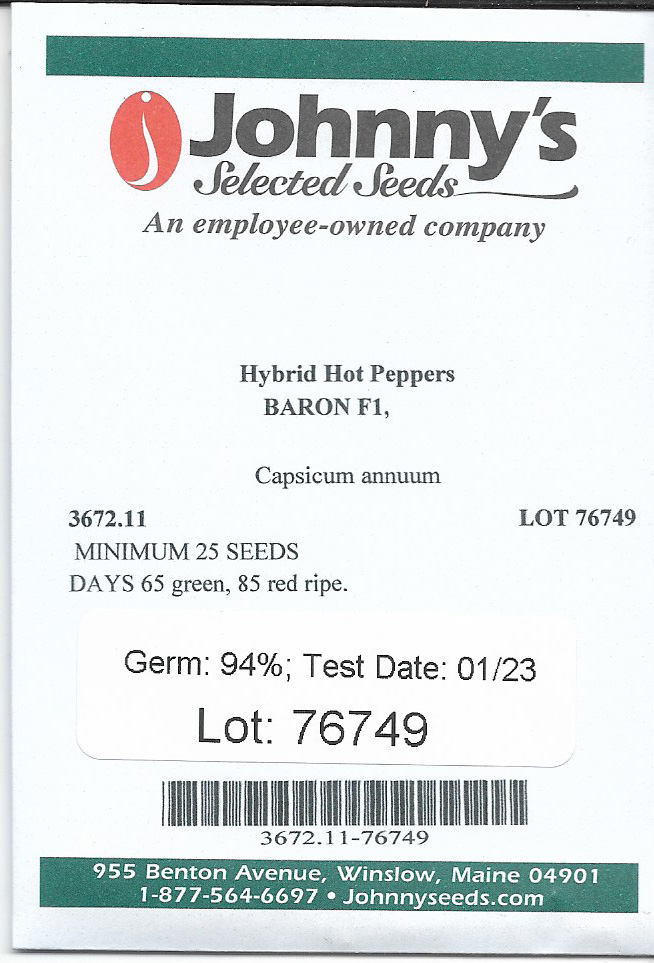 |
d) Baron (F1) Poblano Pepper Seed (ancho) This widely adapted pepper performs particularly well under challenging conditions. The fruits are very large, avg. 5" x 3", and are typically 2-lobed, which makes them easy to stuff and cook in their signature dish, chile rellenos. They also may be dried and ground into medium-hot powder or flakes. 65 days to green; 85 to red ripe
|
||
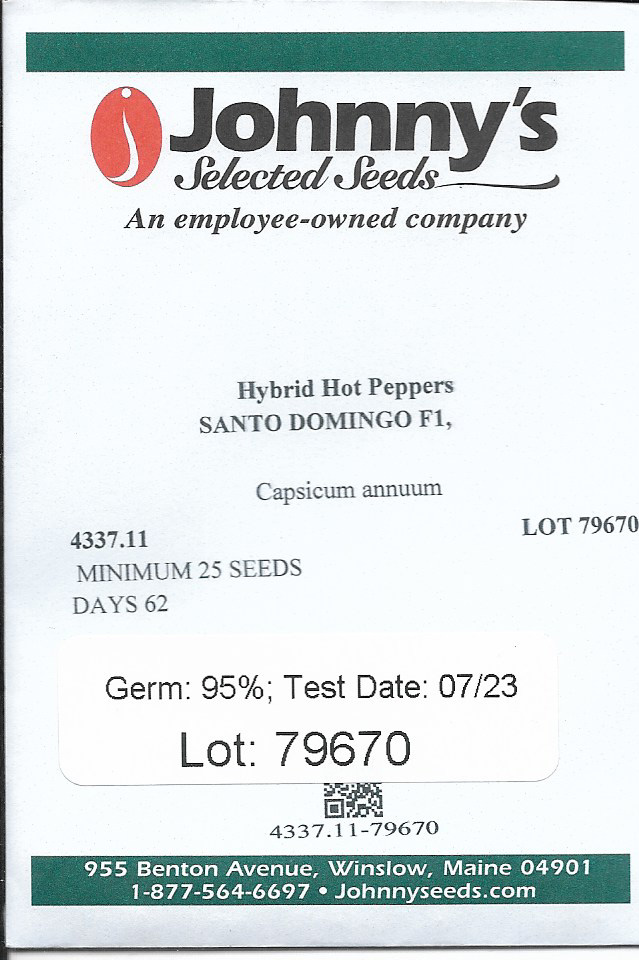 |
e) Santo Domingo (F1) Serrano Pepper Seed (Similar to Altiplano) Santo Domingo has a bigger plant than Altiplano and yields over a longer period of time. Fruit averages 4 1/2–5" long. The larger fruit size makes harvest faster than the traditional, shorter-fruit types. Standard serrano flavor and pungency. |
||
| 20 Spinach (Start seedlings on February 16) Sprouts in 7-14 days Ideal temp: 45-75 F Seed depth: 1/2 inch Plant spacing 7" Min. full sun: 3-10 hours Spinach is a cool-season vegetable that prefers sunny locations and fertile, well-drained soil. Plant seeds ½ inch deep, 2-3 weeks before the last frost in the spring. Thin seedlings or transplant spinach to 3 inches apart in the row with rows 12 inches apart. Spinach tastes best when plants grow rapidly and mature before the heat of summer. Avoid water or fertilizer stress during growth. Control insects and diseases throughout the year. Harvest spinach when the leaves reach full size. Spinach seed can be sown after soils reach 40 degrees F. Seeds germinate best at 55-65 degrees F and require 7-10 days to emerge. Temperatures above 80°F reduce seed germination. Seeds should be planted ½ inch deep. Thin stands when plants have 3-4 true leaves. Plants removed at thinning can be transplanted to adjacent areas if some roots are maintained. Thinned plants can also be eaten. Transplants should have 4-6 mature leaves and a well-developed root system before planting out. Generally 5-6 weeks are required to grow transplants to this size. Seeded or transplanted spinach should be spaced 3 inches between plants in the row with rows 12 inches apart. Dense plantings will reduce weed pressure. Spinach grows best when temperatures do not exceed 75°F. Apply ¼ cup per 10 foot of row of a nitrogen-based fertilizer (21-0-0) 4 weeks after transplanting or at thinning to encourage rapid plant growth. Place the fertilizer to the side of the plants and irrigate it into the soil. High summer temps reduce growth, decrease quality, and cause the plants to flower and the leaves to develop bitter or off-flavors. For fall spinach, select early maturing cultivars and plant 50-75 days before the anticipated maturity date. Plants can be left in the garden after light frosts. Spinach will easily over-winter for an early spring crop if the plant has 4-5 true leaves formed late in the year. When over-wintering spinach, mulch the plants heavily and remove the mulch after the snow melts in the spring. Water spinach regularly. Mulch around the plant also helps conserve soil moisture and reduce weed growth. Moisture fluctuations will cause leaves to become tough, slow leaf development, and contribute to off-flavors. Try to keep water off the leaves in the evening.  |
|||
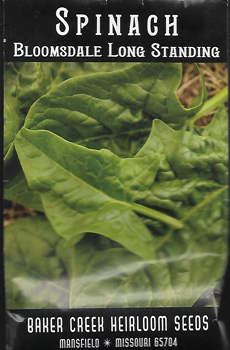 |
a) Bloomsdale
|
||
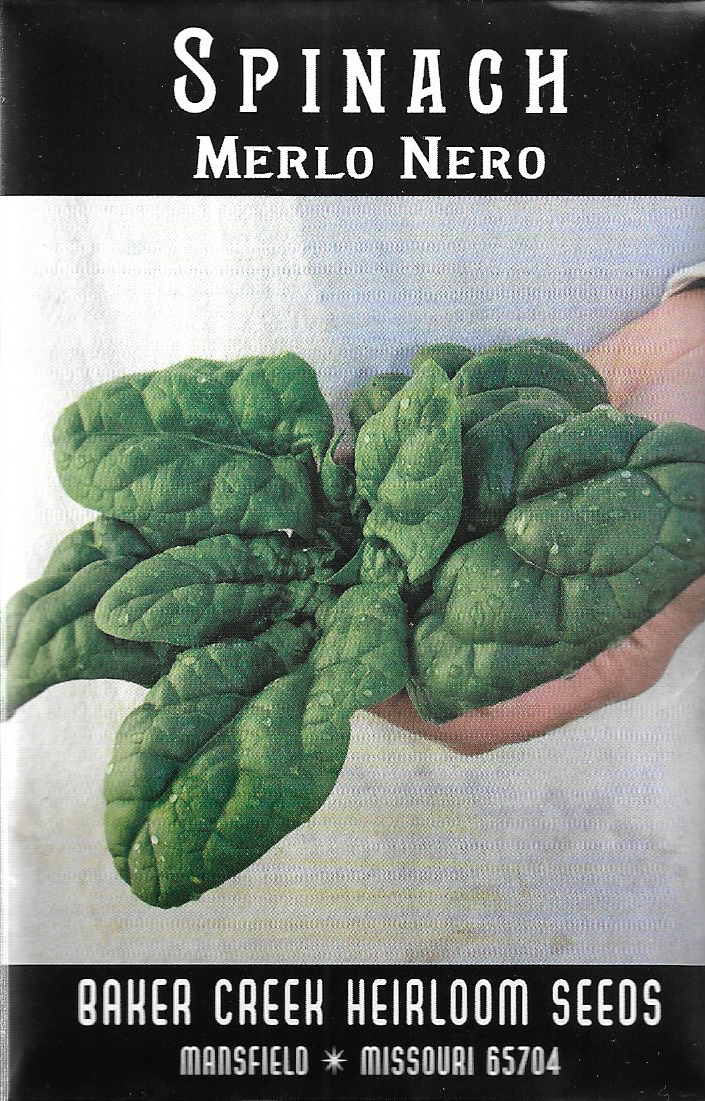 |
b) Merlo Nero A fine-flavored Italian spinach that has dark-green, savoyed leaves. This productive variety is fairly early. Rare in the U.S.
|
||
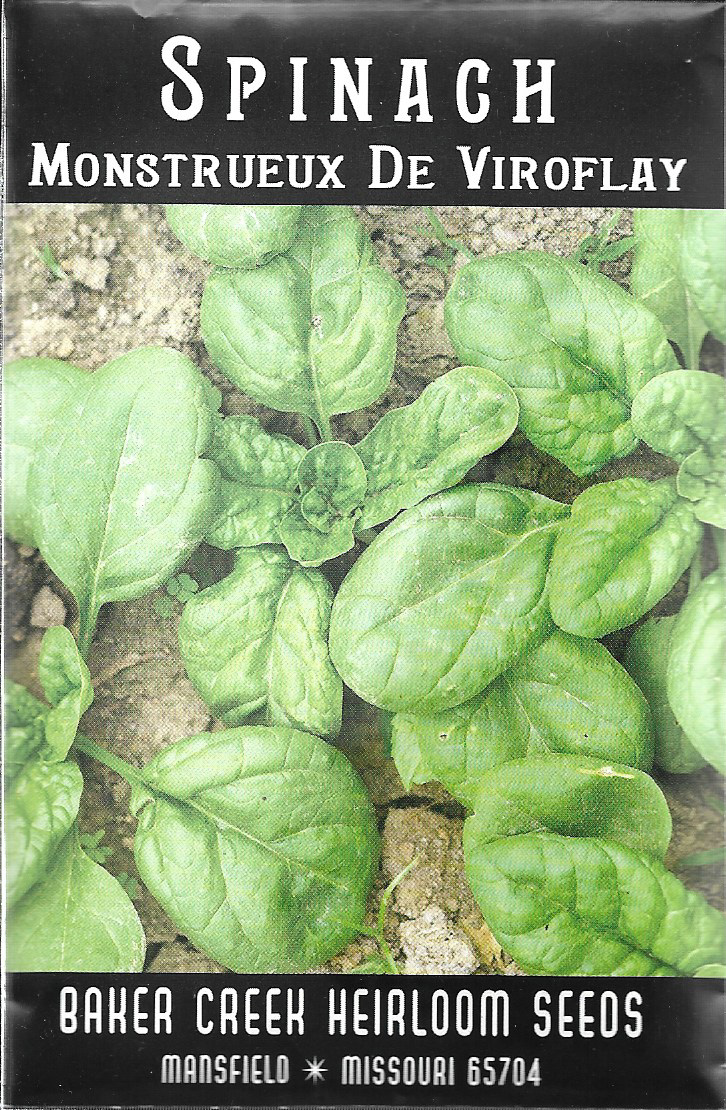 |
c) Monstrueux Big leaves to 10 inches long, smooth and deep green in color. Very fast growing plants are popular for fall planting. A gourmet French heirloom that was developed prior to 1866.
|
||
| 22 Tomatillo (Start seedlings on February 16) Sprouts in 7-14 days Ideal temp: 75-95 F Seed depth: 1/8 inch Plant spacing : Big pots Min. full sun: 8-12 hours Tomatillos grow 3-4 feet tall and wide and rarely suffer from disease or pest damage. Plants can be started indoors, 6-8 weeks before planting date. They are semi-drought tolerant, requiring 1-2 inches of water per week. Plant at least two tomatillo plants to achieve proper fertilization for fruit production. Allow six to eight weeks to grow transplants. Plants should have five to seven leaves and a well-developed root system before planting. Germinate seeds at 80°F until the seed root emerges, then plant to sterile seeding mix and grow out at 65-70°F. Good light is essential to produce quality transplants. Cool white fluorescent tubes, 2-3 inches above the plants, lit for 14-16 hours per day, will ensure plants grow big and healthy. Water regularly and feed weekly with half-strength, soluble, complete fertilizer before planting into the garden. Transplants mature four to five weeks before seeded tomatillos. Avoid over-fertilizing tomatillos, which causes excess leaf growth and delays fruit set and maturity. Side dress each plant with 1 tablespoon of (21-0-0) fertilizer, sprinkled around the plants at four and eight weeks after transplanting, then water in the fertilizer. Start seeds indoors 6-10 weeks before the last frost. Using a heat mat helps to warm the soil and speed germination. Seeds germinate in 7-14 days. Seeds germinate at 75-95 F. Sow seeds ¼ inch deep. Grown much like a tomato, but it is a lighter feeder. In order for the tomatillo flowers to set fruit, you must grow at least two tomatillo plants. Tomatillos like fun sun and rich, well-drained soil that is slightly acidic to neutral. They are moderately drought tolerant but do best with an inch or so of water a week. Like tomatoes, tomatillos should be planted deeply, as they produce roots all along the stems. Set plants about three feet apart, giving them plenty of room to spread out. They will grow to be 3 to 4 feet tall. Plants should begin producing fruit in about 75 to 100 days. They are incredibly prolific and fruit nonstop until killed by frost.  |
|||
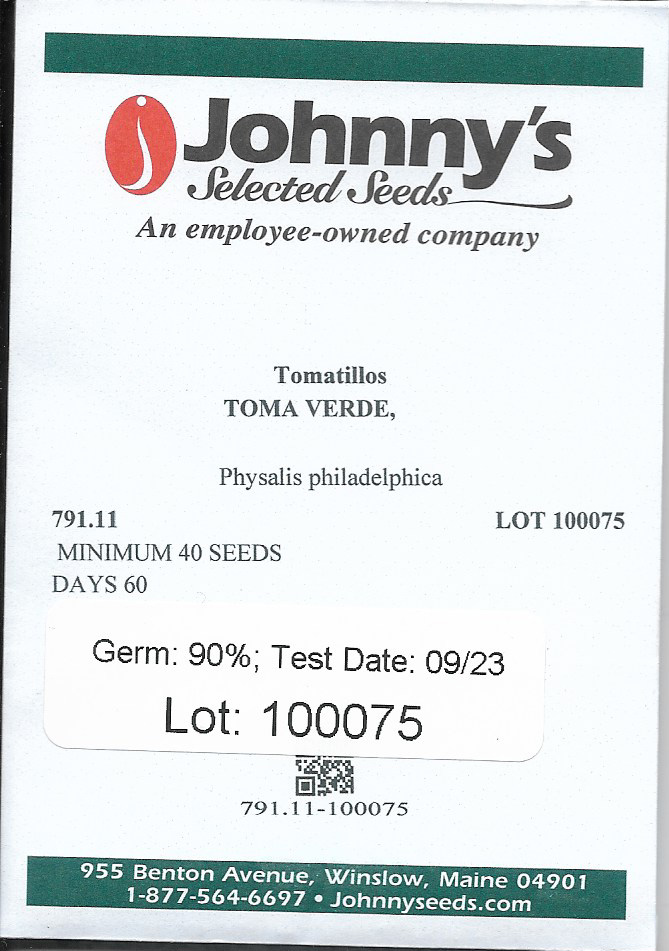 |
a) Toma Verde
Early maturing, large, flat-round green fruits. Use in salsa or Mexican cooking. Grow as tomato ! |
||
23 Tomatoes(Started seedlings on February 10) Mostly going for paste tomatoes these days; along with a few slicers for salads. A couple of days before transplanting seedlings, shower them with an aspirin spray to give the seedlings an immunity boost to avoid transplant shock before they go in the garden. Dissolve a regular-strength, uncoated aspirin tablet (325 mg) in a gallon-size sprayer or watering can and thoroughly spray all the leaves, making sure to get the undersides. Dig a generous amount of well-rotted manure into the top 8 to 12 inches (20-30 cm.) of soil at planting time. Manure is nutrient-rich but low in phosphorus, so add bone meal along with the poop. Toss in a fish head and a couple more aspirins. Any seafood will do, fresh or frozen, but heads are the coolest. Toss in a banana skin, then add about a half-cup of fertilizer specially formulated for tomatoes or vegetables and about a quarter-cup of bone meal. Cover with soil and water it. Pinch off the bottom two or three sets of leaves and bury the plant 8-12 inches deep where the next set of leaves is. Bury them as deep as you can; the deeper it is the more roots it will grow. Water it in well, maybe a gallon or so. From now on, only water when the top 3 or 4 inches are dry, then water deep. Three or four weeks after planting side-dress plants with fertilizer. Side-dressing: Use a water-soluble fertilizer for tomatoes grown in containers. Mix the fertilizer in a watering can at a rate of about 1 tablespoon (15 ml) per gallon. Apply every ten days or so throughout the season. Avoid applying it during very hot or very dry conditions. Barely cover the seeds and germinate on a heating mat under a humidity dome. Once sprouts appear, remove the dome. They require good light to grow well. That's where the LED units come in. They'll need 5-8 weeks for the seedlings to grow big enough to transplant. They may need to be fed once or twice to make good growth prior to transplanting. Tomatoes need plenty of warm weather and a long growing season. 2.5-3 months after. Avoid over-fertilizing tomatoes which causes excess leaf growth and delays fruit set and maturity. Side dress each plant with 1/2 tablespoon of (21-0-0) fertilizer, sprinkled around the plants at 4 and 8 weeks after transplanting, then water in the fertilizer. Plant them with chili peppers, marigolds, borage, chives, nasturtiums, basil, calendula, sage, onions and garlic. If you find a hornworm that appears to have grains of white rice glued to its sides, it’s been parasitized, and that means the beneficial Braconid wasps have arrived to the rescue! Leave this hornworm in place as a nursery, and when the eggs hatch, the wasp larvae will eat the hornworm.
|
|||
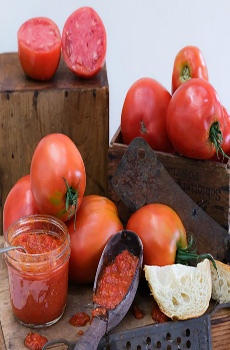 |
Amish Paste Many seed savers believe this is the ultimate paste tomato. Giant, blocky, Roma type tomatoes have delicious red flesh that is perfect for paste and canning. It has world-class flavor.
These did very well in 2024. Will do them again. |
||
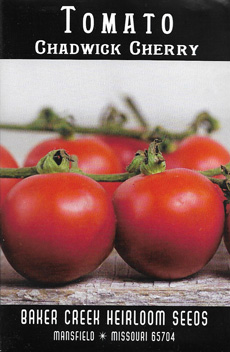 |
(Solanum lycopersicum). The delicious, sweet flavor makes this 1-ounce cherry popular with home gardeners. Large vines set huge yields and are disease-resistant. Developed by the late horticultural expert Alan Chadwick. He sure had a winner with this one!
|
||
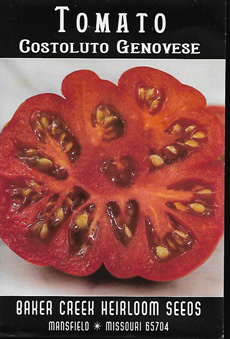 |
(Solanum lycopersicum). The fluted old Italian favorite that has been around since the early 19th century. Fruit is rather flattened and quite attractive with its deep ribbing. This variety is a standard in Italy for both fresh eating and preserving, and known for its intensely flavorful, deep red flesh. This variety has also become very popular with chefs in this country.
|
||
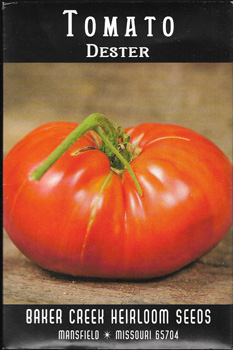 |
Solanum lycopersicum). A large pink beefsteak variety that reaches 1 to 1-1/2 pounds. Its rich sweet flavor makes it an excellent slicer. The seed came to us from an Amish lady who lives just a few miles from our Baker Creek farm. Anna worked as a house cleaner for Dr. Dester and his wife in Indiana in the 1970s. Having acquired the seed from Germany, the Desters shared their favorite tomato seed with Anna, who treasured it and now shares it with us. One of our best-tasting tomatoes.
|
||
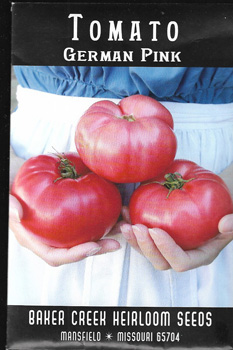 |
(Solanum lycopersicum). One of the tomatoes that originally ignited the heirloom movement in America, this variety originated in Bavaria. It made its U.S. debut in 1883, brought here by Michael Ott, a great-grandfather of Seed Savers Exchange co-founder Diane Ott Whealy. The luxuriant potato-leaf plants give high yields of 1- to 2-pounds, with nearly seedless meaty fruit. The prestigious Slow Foods USA Ark of Taste enthused: “a full sweet flavor, even floral, and...tender skinned.” This gorgeous pink fruit is extremely versatile, excellent for canning and freezing but also for slicing and juicing. This one is sure to become a favorite in your garden!
|
||
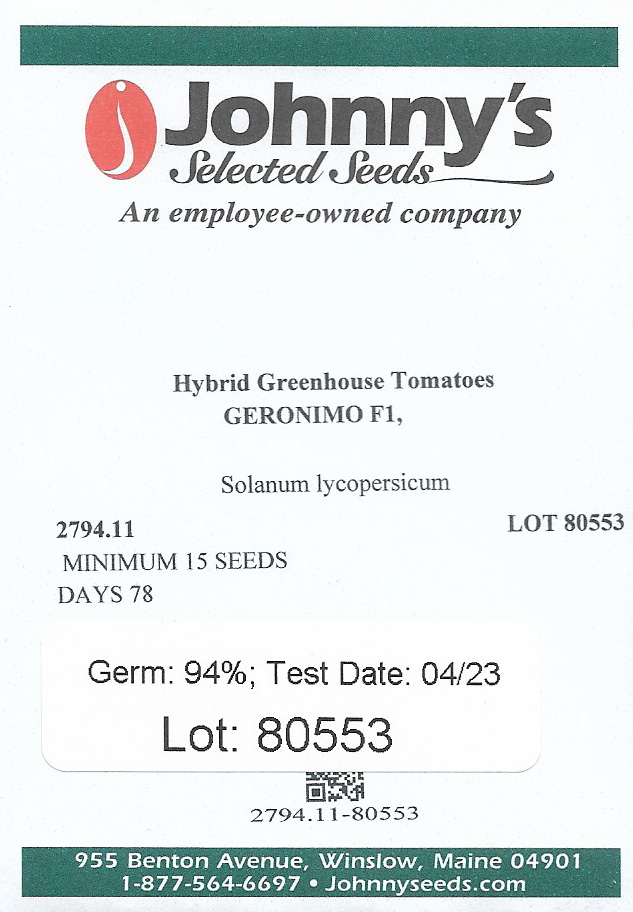 |
Geronimo Greenhouse tomatoes ... good luck! (F1) Tomato Seed Good flavor and mildew tolerance. Firm, 8-10 oz. fruit is produced on vigorous plants with good balance. A perennial yield leader, Geronimo has stood up well to powdery mildew pressure in our high tunnel trials. Indeterminate. Fusarium Wilt races 1, 2 (High) These did very well in 2024. Will do them again. |
||
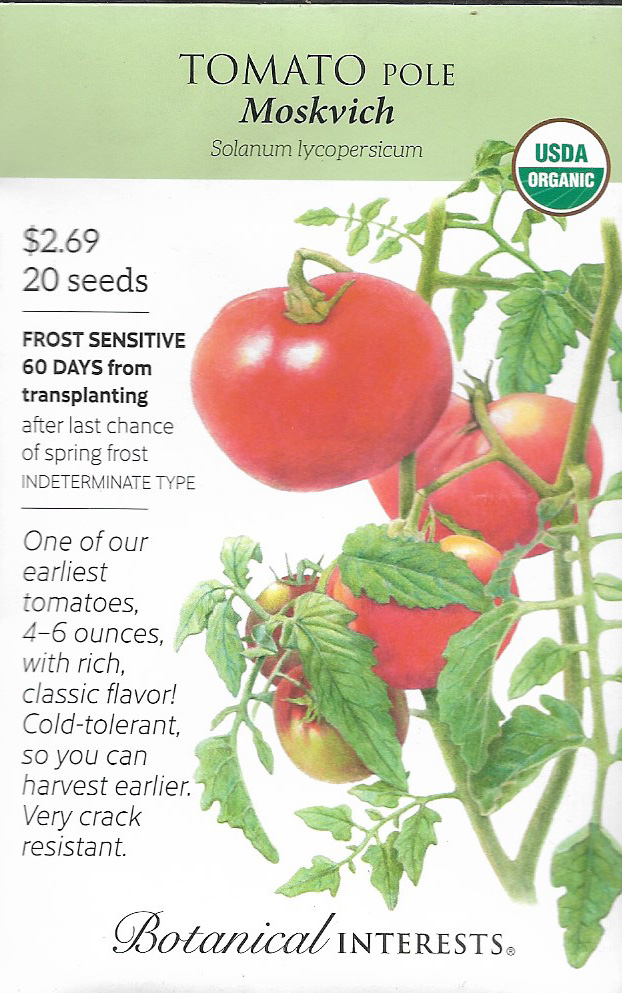 |
Moskvich Moskvich' translates to "inhabitant of Moscow", paying homage to the area where it was bred in the early 1970s (more information inside packet). After a winter without homegrown tomatoes, it will be the first one you will harvest, as it withstands cool weather. At the end of the hot summer when temperatures cool off, it is the last to slow down in production of full-size, garden-fresh fruit. Days to Maturity: 75–80 days from transplanting Family: Solanaceae Type: Indeterminate, Slicer Native: Andes Hardiness: Frost-sensitive annual Plant Dimensions: Vines up to 6' or longer Variety Info: Globe-shaped, 4–6 oz. fruits are deep red. Plants are more cold tolerant than other tomato varieties. 'Moskvich' is an indeterminate type tomato developed in the early 1970s at the Vavilov Institute of Plant Industry near St. Petersburg, Russia. Attributes: Cold Tolerant These did very well in 2024. Will do them again. |
||
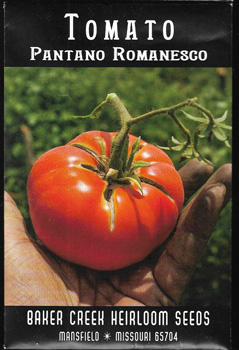 |
(Solanum lycopersicum). An Italian heirloom that was sent to us by Mr. Barbetti. The fruit is large and deep red, with almost a purple tint. The flesh is very rich, flavorful, and juicy. An excellent tomato for home and market gardeners; very rare and delicious.
|
||
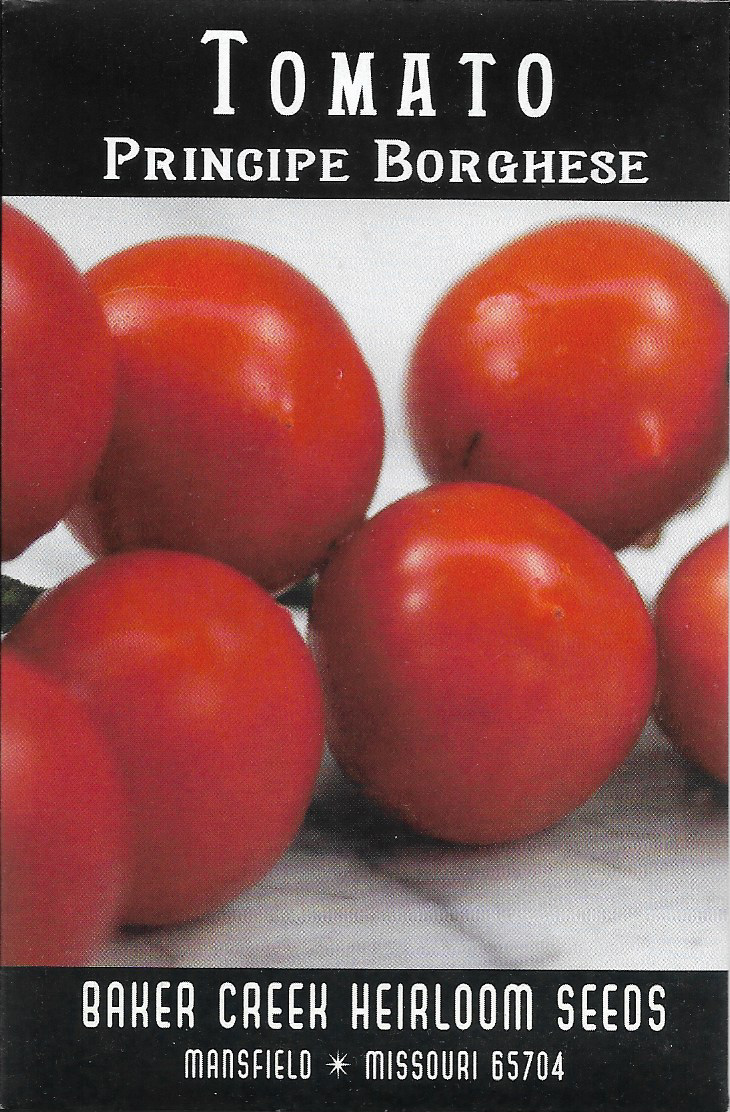 |
Principe Borghese Famous for sun drying. Small 1-to 2-oz, grape-shaped fruit is very dry and has few seeds. It has a rich tomato taste that is wonderful for sauces. Vines yield clusters of fruit in abundance, perfect for selling in fresh markets and making specialty products. We offer pure Italian seed.
These did very well in 2024. Will do them again. |
||
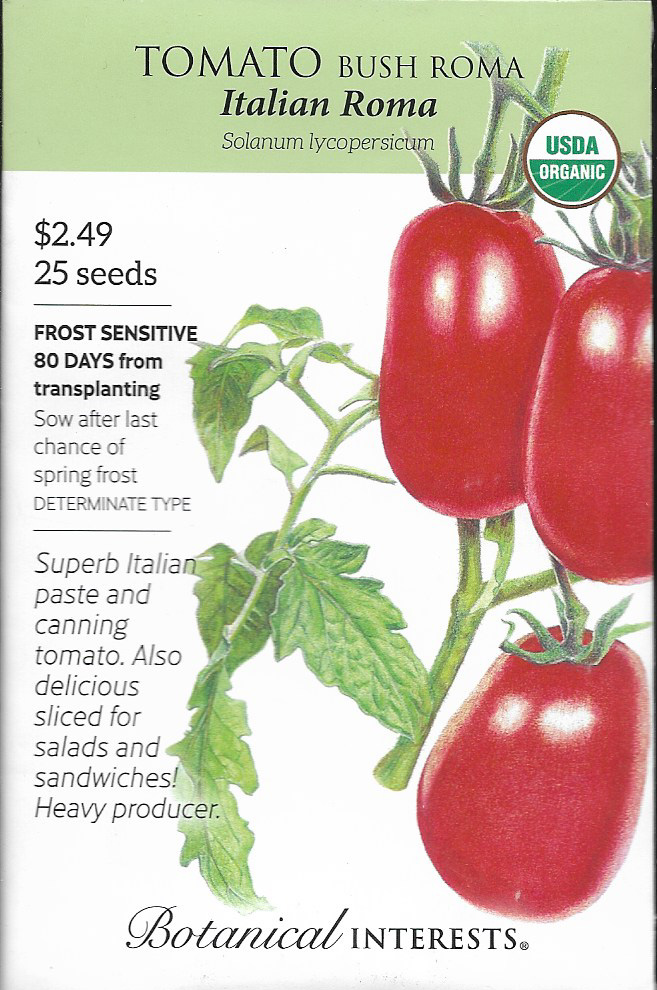 |
Italian Roma (bush) An absolutely excellent heirloom tomato—firm, meaty, 3" oblong fruits with few seeds, on compact vines that are very productive. As a determinate type, most of the fruits ripen at the same time, which makes this tomato a good choice for canning. In areas with a long growing season, a second planting will double your harvest! Days to Maturity: 80 days from transplanting Family: Solanaceae Type: Determinate, Paste, Slicer Native: Andes Hardiness: Frost-sensitive annual Plant Dimensions: About 36" tall, 18" wide Variety Info: 3" x 1 ½", 5-6 oz. oblong, red fruits with few seeds. Italian 'Roma' is a determinate type tomato. These did sensationally in 2024. Will do them again. |
||
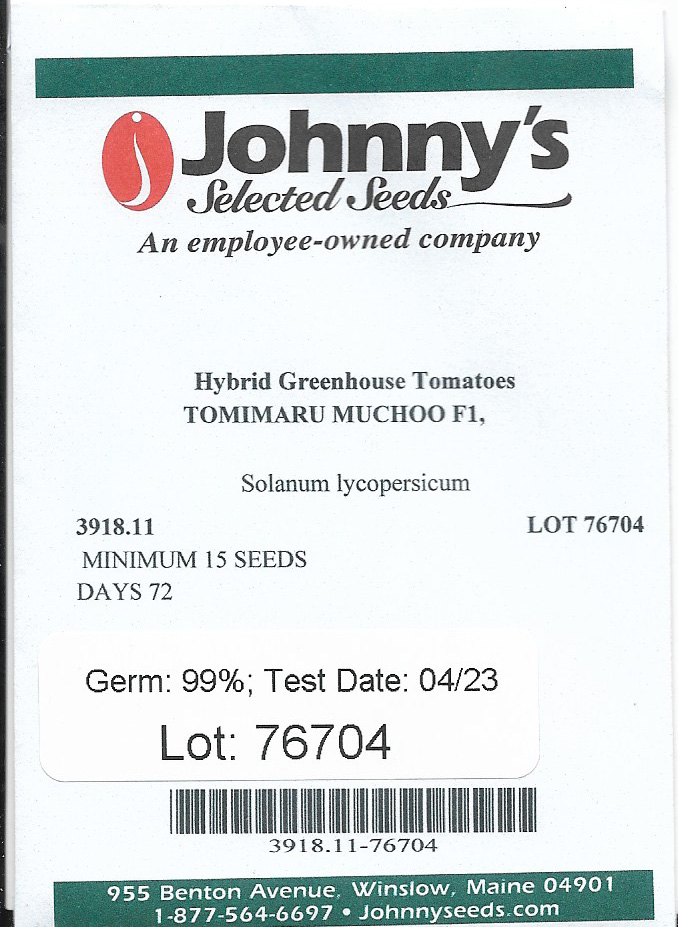 |
Tomimaru Muchoo Greenhouse tomatoes ... good luck! (F1) Tomato Seed Asian-type pink greenhouse slicer. Pink tomatoes are preferred in Asia for their sweet, less acidic flavor profile. This Japanese-style, 6–8 oz. slicer exemplifies pink tomato flavor, and has an appealing, medium-firm texture. Vigorous plants with a broad disease resistance package for indoor growing. Indeterminate. Fusarium Crown and Root Rot (High) These did very well in 2024. Will do them again. |
||
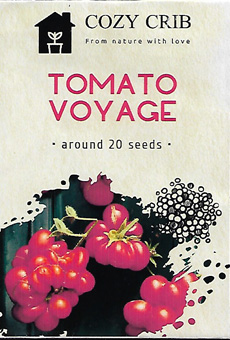 |
Trying these out on the persistent requests by Yvonne. Hopefully they will be delicious. | ||
![]()

